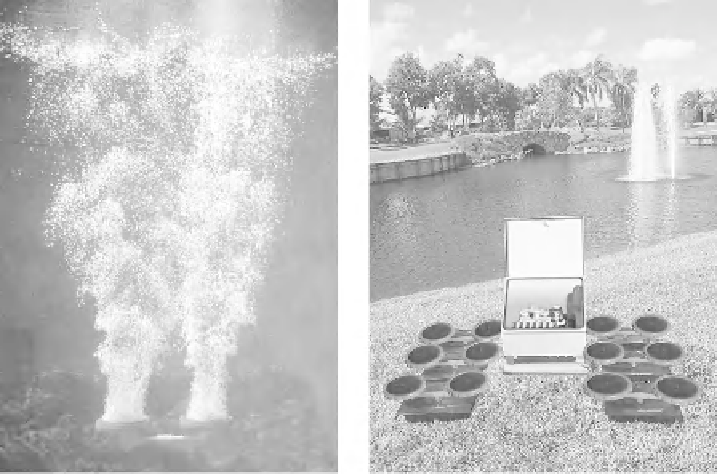Environmental Engineering Reference
In-Depth Information
sulfate except in emergency circumstances. Typical
effective copper sulfate concentrations are 1-2 mg/L.
Application methods include dissolving the copper
sulfate crystals using porous bags pulled by a boat and
using specifically designed boats with either an applica-
tion hopper that feeds copper sulfate crystals directly to
the surface of the water body, or with a spray pump
through which dissolved copper sulfate is sprayed along
the water surface. Timing of application is important.
Regular monitoring of algal numbers or chlorophyll
a
to determine when algal blooms begin will allow the
application of the algicide before an algal bloom
develops.
7.6.2.1
Artificial Circulation.
Artiicial circulation
eliminates thermal stratification, or prevents its forma-
tion, either by the injection of compressed air from a
pipe or ceramic diffuser at the bottom of the lake to
form bubble plumes or by mechanical mixing. Bubble
plumes have the advantages of being able to cover a
greater horizontal extent and having shore-based
mechanical parts, while mechanical mixers have the
advantage of being able to directly access and entrain
oxygen-rich surface waters.
An example of a ceramic-diffuser system is illus-
trated in Figure 7.16, where two operational diffusers
releasing air bubbles are shown in Figure 7.16a and the
controller surrounded by diffuser units is shown in the
foreground in Figure 7.16b. If sufficiently powered,
the rising column of bubbles will produce lakewide
mixing. As a result, the conditions that create hypolim-
netic oxygen depletion (isolation of the deeper waters
from the atmosphere with little to no primary produc-
tion in these deeper, darker waters) are eliminated.
Artificial circulation is one of the most commonly used
lake restoration techniques. The technique is best used
in lakes that are not nutrient limited; nutrient concen-
trations are often higher in the hypolimnion, and as a
result, mixing can stimulate increased algal growth. In
addition, artificial circulation is not a feasible option for
coldwater fish species, which use the hypolimnion as a
thermal refuge during summer. If applicable, aeration-
destratification must begin at the time of vernal
7.6.2 Control of DO Levels
Low levels of DO may occur in lakes as a result of
natural conditions, as well as cultural eutrophication.
Thermal stratification in lakes is often driven by strong
solar heating of near-surface waters in the summer, with
the resulting stratification limiting the transport of
oxygen to hypolimnetic waters. As a consequence, the
lowest concentrations of DO tend to occur in the deeper
waters of the hypolimnion during thermal stratification
in late summer. Similar conditions also occur during
long periods of snow and ice cover in winter, or in dense
macrophyte beds at night or following long periods of
cloud cover. Problems with low DO can be alleviated
by artificial circulation and aeration.
(a)
(b)
Figure 7.16.
Diffused-air circulation system. (a) Air diffusers in operation; (b) controller surrounded by diffuser units.
Source
: vertex
Water Features, Inc. (2005).

Search WWH ::

Custom Search